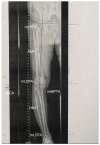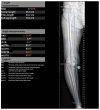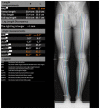Enhancing Precision and Efficiency in Knee Arthroplasty: A Comparative Analysis of Computer-Assisted Measurements with a Novel Software Tool versus Manual Measurements for Lower Leg Geometry
- PMID: 38137650
- PMCID: PMC10743611
- DOI: 10.3390/jcm12247581
Enhancing Precision and Efficiency in Knee Arthroplasty: A Comparative Analysis of Computer-Assisted Measurements with a Novel Software Tool versus Manual Measurements for Lower Leg Geometry
Abstract
(1) Background: The aim of this prospective study was to evaluate measurement software in comparison with manual measurements using inter-observer and intra-observer variability on radiographs in the preoperative planning of total knee arthroplasty. (2) Methods: Two independent observers retrospectively measured the mechanical lateral proximal femoral angle (mLPFA), the mechanical lateral distal femoral angle (mLDFA), the joint line convergence angle (JLCA), the mechanical medial proximal tibial angle (mMPTA), the mechanical lateral distal tibial angle (mLDTA), the hip-knee angle or mechanical tibial-femoral axis angle (HKA), and the anatomical-mechanical angle (AMA) on 55 long-leg anteroposterior radiographs manually twice, followed by measurements using dedicated software. Variability between manual and computer-aided planning was assessed, and all measurements were performed a second time after 14 days in order to assess intra-observer variability. (3) Results: Concerning intra-observer variability, no statistically significant difference was observed regarding the software-based measurements. However, significant differences were noted concerning intra-observer variability when measuring the mLDFA and AMA manually. Testing for statistical significance regarding variability between manual and software-based measurements showed that the values varied strongly between manual and computer-aided measurements. Statistically significant differences were detected for mLPFA, mLDFA, mMPTA, and mLPTA on day 1, and mLPFA, mMPTA, and mLPTA on day 15, respectively. (4) Conclusions: Preoperative planning of leg axis angles and alignment using planning software showed less inter- and intra-observer variability in contrast to manual measurements, and results differed with respect to manual planning. We believe that the planning software is more reliable and faster, and we would recommend its use in clinical settings.
Keywords: leg axis; leg axis alignment; leg axis angles; planning software.
Conflict of interest statement
Andreas Leithner and Patrick Sadoghi received industrial grants from DePuySynthes, alphamed, and Medacta not related to the submitted manuscript. The remaining authors have no potential conflict of interest to declare.
Figures



References
LinkOut - more resources
Full Text Sources

